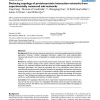Free Online Productivity Tools
i2Speak
i2Symbol
i2OCR
iTex2Img
iWeb2Print
iWeb2Shot
i2Type
iPdf2Split
iPdf2Merge
i2Bopomofo
i2Arabic
i2Style
i2Image
i2PDF
iLatex2Rtf
Sci2ools
BMCBI
2008
2008
Deducing topology of protein-protein interaction networks from experimentally measured sub-networks
Background: Protein-protein interaction networks are commonly sampled using yeast two hybrid approaches. However, whether topological information reaped from these experimentallymeasured sub-networks can be extrapolated to complete protein-protein interaction networks is unclear. Results: By analyzing various experimental protein-protein interaction datasets, we found that they are not random samples of the parent networks. Based on the experimental bait-prey behaviors, our computer simulations show that these non-random sampling features may affect the topological information. We tested the hypothesis that a core sub-network exists within the experimentally sampled network that better maintains the topological characteristics of the parent protein-protein interaction network. We developed a method to filter the experimentally sampled network to result in a core sub-network that more accurately reflects the topology of the parent network. These findings have fundamental implications f...
| Added | 09 Dec 2010 |
| Updated | 09 Dec 2010 |
| Type | Journal |
| Year | 2008 |
| Where | BMCBI |
| Authors | Ling Yang, Thomas M. Vondriska, Zhangang Han, W. Robb MacLellan, James N. Weiss, Zhilin Qu |
Comments (0)

